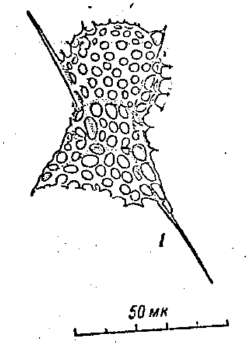|

|
|
Lophophaena clevei
Petrushevskaya, 1971
|
Description - Add description
Lophophaena clevei
Material. 12 skeletons from the sediments at 6 stations ["Sevastopol", 2104 (holotype in the preparation No. 1, F 42, 2 in the Department of Marine Protozoans, ZIN, Academy of Sciences USSR) and "Obj", 34, 37, 55, 177 and 272].
Diagnosis. Lophophaena which is very close to the Paleogene representatives of the genus (fig. 56, XIII). The lateral lobes are clearly expressed as "neck" inflations. The lower part of the II segment is cylindrical. The ratio of the widths of segment I and II equals 1 : 1.3. The rounded, densely spaced pores on both segments are of an equal size. Their diameter does not exceed more than 1.5-3 times the width of the septa between them. Spines D, Lr and Ll yield considerably long terminal legs, whereas the secondary apophyses of the margin of the shell (radial appendages) are not expressed. There are no long filamentous spines on the I segment, but merely short spines instead, which are specifically developed in the area of the "neck". These short spines can merge with the apophyses and form an outer net which envelopes the "neck".
Measurements. Length of I segment (without "neck") approximately 0.03 mm, width 0.030-0.035 mm; length of II segment 0.06 mm and over, width 0.050-0.055 mm.
Distribution. Bipolar: Norwegian Sea, Arctic and Antarctic.
Taxonomic remarks. Differs from Lithomelissa laticeps, described by Jörgensen, in the distinctly developed "neck", which is separated from the thorax by arches cp and pp. The species has been named in honour of P. T. Cleve, the first scientist to discover this species. | | Petrushevskaya 1971 |
|
|
 |

|